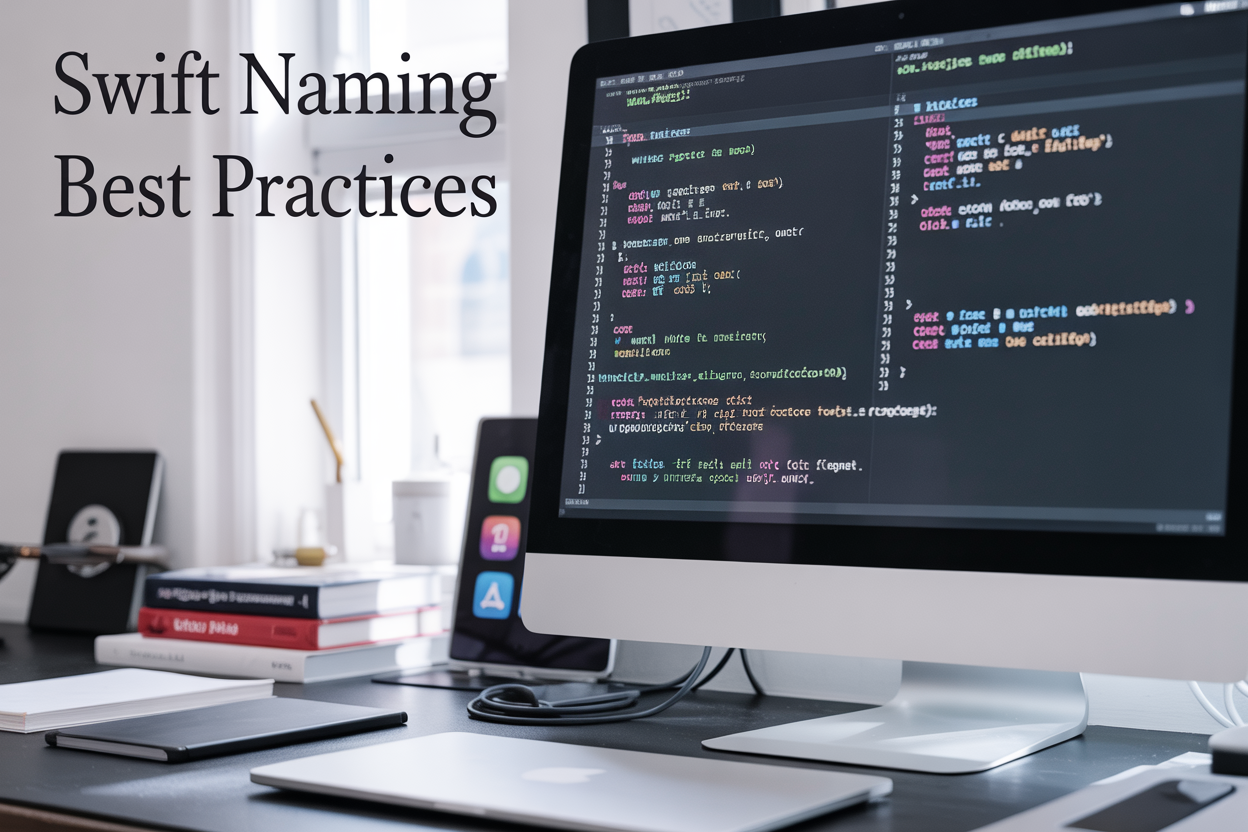Clean, consistent code makes all the difference between a project that scales smoothly and one that becomes a maintenance nightmare. This guide covers Swift naming conventions and Swift coding standards that every iOS developer needs to master, whether you’re building your first app or leading a development team.
You’ll learn the Swift best practices that top iOS developers swear by, from choosing clear variable names to organizing your project files like a pro. We’ll dive into Swift code formatting rules that make your code readable at a glance, explore powerful Swift programming patterns that solve common problems elegantly, and share iOS development coding guidelines that keep your team on the same page.
By the end, you’ll have a toolkit of proven techniques for writing clean Swift code that your future self (and your teammates) will thank you for. We’ll cover essential naming conventions that eliminate confusion, file organization strategies that save hours of hunting through code, and team collaboration tools that keep everyone’s code looking consistent across your entire project.
Essential Swift Naming Conventions for Clean Code
Variables and Properties Using Descriptive CamelCase
Choose variable names that clearly express their purpose and content. Swift naming conventions require camelCase for variables and properties, starting with lowercase letters. Name your variables with descriptive words that eliminate guesswork – userAccountBalance beats balance, and isNetworkConnectionActive trumps isActive. Avoid abbreviations and single-letter variables except for loop counters. Boolean properties should start with is, has, or can to make their true/false nature obvious. Private properties can use leading underscores sparingly, but descriptive names remain the priority.
Functions and Methods That Communicate Intent Clearly
Function names should read like natural language sentences, describing exactly what the function accomplishes. Start with action verbs and include parameter labels that clarify the relationship between arguments. Swift’s parameter naming system lets you create functions that read beautifully: calculateDistance(from: startPoint, to: endPoint) tells the whole story. Omit needless words while maintaining clarity – user.save() works better than user.saveUserToDatabase(). For functions returning Boolean values, use verbs like contains, matches, or validates to make the return type obvious.
Classes and Structures Following CapitalCase Standards
Class and structure names use CapitalCase (PascalCase), starting with uppercase letters for each word. Choose names that represent the entity’s core responsibility and role in your application. Generic names like Manager or Helper often indicate design problems – be specific about what the class actually manages or helps with. Prefer nouns over adjectives, and avoid redundant suffixes unless they add meaningful distinction. Protocol names should describe capabilities using -able or -ing suffixes, like Drawable or NetworkConnecting.
Constants and Enums for Better Code Readability
Constants use camelCase like variables, but choose names that emphasize their unchanging nature and significance. Global constants can use more descriptive prefixes to avoid naming conflicts. Enum cases follow camelCase and should read naturally when combined with the enum name – NetworkStatus.connecting flows better than NetworkStatus.isConnecting. Group related constants into enums or nested structures to create logical namespaces. Use raw values for enums when they need to interface with external systems, but prioritize meaningful case names over convenient raw values.
File Organization and Project Structure Best Practices
Logical File Grouping for Scalable Projects
Organizing Swift files by feature rather than file type creates maintainable codebases that scale with your team. Group related models, views, and controllers together in feature-specific folders instead of separating them into generic “Models” or “Views” directories. This Swift file organization approach helps developers quickly locate code and reduces merge conflicts when multiple team members work on different features simultaneously.
Directory Structure That Enhances Team Collaboration
A well-structured directory hierarchy prevents code chaos and streamlines team workflows. Create dedicated folders for shared utilities, extensions, and resources while maintaining clear separation between core business logic and UI components. Establish consistent naming patterns for folders and enforce them through team guidelines. This Swift coding standards approach ensures new team members can navigate the project effortlessly and contributes to better code consistency across your development team.
Import Statement Organization for Faster Compilation
Properly organized import statements significantly impact compilation speed and code readability in Swift projects. Group imports logically with system frameworks first, followed by third-party dependencies, then internal modules. Remove unused imports regularly and avoid importing entire frameworks when you only need specific components. Use @testable import only in test files and consider using import aliases for frequently used complex module names to maintain clean Swift code throughout your project.
Code Formatting Standards for Professional Development
Consistent Indentation and Spacing Rules
Professional Swift code formatting relies on consistent 4-space indentation throughout your project. Avoid mixing tabs and spaces, as this creates visual inconsistencies across different editors. Use single spaces around operators (let sum = a + b) and after commas in parameter lists. Remove trailing whitespace from line endings to maintain clean diffs in version control. Configure Xcode to show invisible characters during development to catch spacing issues early.
Line Length Limits for Better Code Review
Keep Swift lines under 120 characters to ensure readability across different screen sizes and code review tools. Break long function calls into multiple lines, placing each parameter on its own line with proper alignment. Chain method calls vertically when they exceed the limit, indenting each subsequent call by 4 spaces. This Swift code formatting practice makes code reviews more efficient and reduces horizontal scrolling in IDEs.
Bracket Placement Conventions
Follow the opening brace on the same line convention for functions, classes, and control structures in Swift coding standards. Place the opening brace after a single space following the declaration. Close braces should align with the start of the statement that opened them. For single-line closures, keep braces on the same line, but for multi-line closures, place the opening brace on the same line and the closing brace on its own line.
Comment Formatting for Clear Documentation
Write meaningful comments that explain why code exists rather than what it does. Use /// for documentation comments that appear in Quick Help, following the standard format with brief descriptions and parameter explanations. Keep inline comments on separate lines above the relevant code. Maintain consistent spacing in multi-line comments using /* */ format. Remove commented-out code before committing to maintain clean Swift code consistency across your team.
Swift-Specific Coding Patterns and Idioms
Optionals Handling with Safe Unwrapping Techniques
Mastering optional unwrapping transforms unsafe code into rock-solid Swift applications. Guard statements provide early exits when values are nil, while optional binding using if let and where clauses creates clean, readable validation patterns.
guard let user = currentUser,
user.isActive else { return }
// Nil coalescing operator for defaults
let displayName = user.name ?? "Anonymous"
// Optional chaining prevents crashes
let profileImage = user.profile?.avatar?.thumbnail
Avoid force unwrapping with ! except when absolutely certain values exist. Use optional map and flatMap for transformations, and implement custom operators sparingly to maintain code clarity across your development team.
Protocol-Oriented Programming Implementation
Swift protocols create flexible architectures that favor composition over inheritance. Define small, focused protocols with specific capabilities rather than massive interfaces that violate single responsibility principles.
protocol Cacheable {
var cacheKey: String { get }
func invalidateCache()
}
protocol NetworkRequestable {
associatedtype Response: Codable
var endpoint: URL { get }
func execute() async throws -> Response
}
// Compose protocols for complex behavior
struct APIService: NetworkRequestable, Cacheable {
// Implementation details
}
Protocol extensions provide default implementations while maintaining type safety. Use associated types with constraints for generic protocols, and leverage protocol composition with & to combine multiple protocols cleanly. This approach creates testable, modular code that adapts to changing requirements without breaking existing functionality.
Error Handling Best Practices for Robust Applications
Structured error handling prevents crashes and improves user experience through clear failure communication. Create custom error types conforming to Error protocol with descriptive cases and associated values for context.
enum ValidationError: Error, LocalizedError {
case emptyField(String)
case invalidFormat(field: String, expected: String)
var errorDescription: String? {
switch self {
case .emptyField(let field):
return "\(field) cannot be empty"
case .invalidFormat(let field, let expected):
return "\(field) must be in \(expected) format"
}
}
}
// Result type for explicit success/failure handling
func validateEmail(_ email: String) -> Result<String, ValidationError> {
guard !email.isEmpty else {
return .failure(.emptyField("Email"))
}
// Additional validation logic
return .success(email)
}
Use throws functions for recoverable errors and Result types when callers need explicit error handling. Avoid catching generic Error types; instead, handle specific error cases with targeted recovery strategies.
Memory Management Through ARC Optimization
Automatic Reference Counting handles most memory management, but understanding retain cycles prevents memory leaks in complex object relationships. Use weak and unowned references strategically to break circular dependencies.
class ViewController {
private var networkService: NetworkService?
func setupNetworking() {
networkService = NetworkService { [weak self] result in
self?.handleResponse(result)
}
}
}
// Unowned for guaranteed non-nil relationships
class Child {
unowned let parent: Parent
init(parent: Parent) {
self.parent = parent
}
}
Capture lists in closures prevent strong reference cycles. Use [weak self] for optional relationships and [unowned self] when objects share identical lifetimes. Profile memory usage regularly using Instruments to identify leaks and optimize allocation patterns in performance-critical code paths.
Extension Usage for Code Organization
Extensions organize code by functionality while maintaining clean separation of concerns. Group related methods together and use extensions to conform to protocols, keeping implementation details focused and discoverable.
// MARK: - Core functionality
class UserManager {
private var users: [User] = []
}
// MARK: - Protocol conformance
extension UserManager: Cacheable {
var cacheKey: String { "user_manager_cache" }
func invalidateCache() { /* implementation */ }
}
// MARK: - Validation
extension UserManager {
func isValidUser(_ user: User) -> Bool {
// Validation logic
}
}
// MARK: - Computed properties
extension User {
var fullName: String {
"\(firstName) \(lastName)"
}
var isActive: Bool {
lastLoginDate > Date().addingTimeInterval(-30 * 24 * 60 * 60)
}
}
Use MARK comments to create logical sections within files. Place extensions in the same file for private functionality, but create separate files for public extensions shared across modules. This approach improves code navigation and makes complex classes more maintainable for development teams.
Performance-Driven Coding Practices
Efficient Collection Usage and Iteration
Choose the right collection type for your specific needs in Swift development. Arrays excel for ordered data and frequent index access, while Sets optimize membership testing and uniqueness requirements. Dictionaries provide fast key-based lookups. When iterating, prefer for-in loops over index-based iteration for better readability and performance. Use enumerated() when you need both index and value. Leverage higher-order functions like map(), filter(), and reduce() for functional transformations, but avoid chaining multiple operations unnecessarily as they create intermediate arrays. Consider using lazy sequences for large datasets to defer computation until actually needed.
String Interpolation vs Concatenation Optimization
String interpolation in Swift coding standards offers better performance and readability compared to concatenation. Use \() syntax for embedding values directly into strings rather than multiple + operations. String interpolation creates a single string buffer, while concatenation generates multiple temporary objects. For complex string building with many components, String(format:) or custom string builders can provide additional optimization. When dealing with large amounts of text or frequent string operations, consider using StringBuilder patterns or joining arrays of strings with joined(separator:) method for better memory management and reduced allocation overhead.
Lazy Loading Implementation for Better Memory Usage
Implement lazy properties to defer expensive computations and reduce initial memory footprint. Use Swift’s lazy keyword for properties that require significant processing or memory allocation. This approach particularly benefits complex object initialization, file I/O operations, and resource-intensive calculations. Lazy loading patterns work well with computed properties that cache results after first access. Consider lazy collections when working with large datasets where only partial data access is expected. Combine lazy initialization with weak references in delegates and closures to prevent retention cycles. This Swift best practice optimizes app performance by loading resources only when actually needed.
Team Collaboration and Code Consistency Tools
SwiftLint Integration for Automated Style Checking
SwiftLint automates Swift coding standards enforcement across your entire project. Install SwiftLint through CocoaPods, SPM, or Homebrew, then create a .swiftlint.yml configuration file to customize rules matching your team’s preferences. Integrate SwiftLint into your Xcode build phases to catch style violations during compilation. Configure your CI/CD pipeline to run SwiftLint checks on every pull request, preventing inconsistent code from reaching your main branch. Popular rules include line length limits, force unwrapping warnings, and proper naming convention enforcement. Custom rules can target project-specific patterns like architectural violations or deprecated API usage.
Code Review Guidelines for Swift Projects
Effective Swift code reviews focus on readability, maintainability, and adherence to established conventions. Review pull requests for proper naming conventions, ensuring variables and functions use descriptive camelCase names. Check for appropriate access control levels – prefer private and fileprivate over internal when possible. Look for force unwrapping (!) and suggest safer alternatives like optional binding or nil coalescing. Verify that error handling uses proper do-catch blocks rather than try! statements. Pay attention to memory management, especially retain cycles in closures. Encourage meaningful commit messages and require tests for new functionality.
Documentation Standards Using Swift Documentation Comments
Swift documentation comments create professional, searchable code documentation that integrates seamlessly with Xcode. Use triple slashes (///) for single-line comments and /** */ blocks for multi-line documentation. Structure documentation with - Parameter: for function parameters, - Returns: for return values, and - Throws: for error conditions. Include usage examples in documentation comments using code blocks. Document public APIs comprehensively while keeping internal documentation concise but meaningful. Use - Note:, - Warning:, and - Important: callouts to highlight critical information. Generate documentation websites using tools like Swift-DocC or Jazzy for team-wide reference materials.
Following solid Swift naming conventions and coding standards makes your code readable, maintainable, and professional. Clean file organization, consistent formatting, and proper use of Swift idioms create a foundation that benefits both individual developers and entire teams. When you stick to performance-driven practices and leverage the right collaboration tools, you’re setting yourself up for long-term success in iOS development.
Start implementing these practices in your current projects, even if it means refactoring existing code. Your future self will thank you when debugging becomes easier, and your teammates will appreciate the consistency. Pick one area to focus on first—whether it’s naming conventions or file organization—and gradually build these habits into your daily coding routine.




















